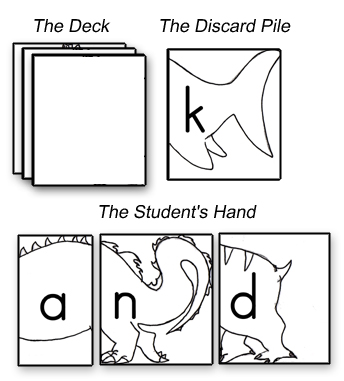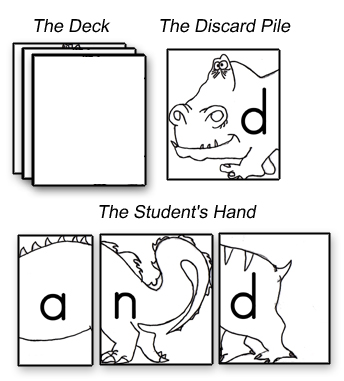![]()
Home | Crosswords | Word Searches | Flash Cards | Verbs | Songs | Creative Writing | Work Sheets | Phonics | ABCs Survival English | Business ESL | ESL for Adults | ESL Articles| Lesson Plans | Young Learners ESL | ESL Jobs |
Other Phonics Worksheet Sections:
initial sounds | final sounds | select patterns | vowel combinations
Other Spelling Worksheets:
first words | first verbs | numbers
Other Reading Games:
Phonics Monsters Rummy!
Phonics Rummy is a game where students get points for making words from the phonics monster cards.
Set up
This game is similar to the card game Rummy except students have to get word sets to get points instead of three of kind or runs. All of the heads, bodies, and tails are mixed up and the students are dealt three (or six cards depending on the variation of game you want to play). The students keep their cards hidden from other players. The remaining cards are put in a pile face down. The first card is flipped up and placed into the discard pile. Note: the body cards are thinner than the tail and head cards so it does give the students some information about what card is coming next, but it doesn't really matter that much.
Game Play
The student who goes first (determined by rocks-scissors-paper) can choose a card from the deck or the last card in the discard pile. The student tries to make a word if he or she can. Even if the student can't make a word, they may wish to improve their hand by choosing the best three out of four cards. These would be the cards that give them the most possibilities. The student then discards one card and the player to the left has a turn. There are many, many possible variations for scoring winning and game play. The teacher will have to choose a suitable variation for his or her class.
Sample Play
Case 1
At the beginning of the student's turn, the student has the body A, the tail N, and the tail D. The Tail K is in the discard pile. This does not really help the student so he or she would probably draw a card from the deck. The student would try to make a monster word out of the four cards. In order to make a word, the student must have a head, a body, and a tail. The student cannot make a word out of two tails and a body for example.

Case 2
At the beginning of the player's turn, the student has the body A, the tail N, and the tail D. The head D is in the discard pile.
If the student picks up the D from the discard pile, he or she can make the word DAD. This is clearly the move to make, so the student picks up the D, spells DAD, lays the word down, and discards the tail N.

Variations:
I have played with so many variations that I can't list them all here. But to give you an idea, here are a few ways to play this game.
Variation 1: First down wins. For this variation, each student is given 6 cards to start. They win when they can lay down two complete words. The first word should be easy as they have six (seven if you count the card they get on their turn) to make a word. The second word will be much harder. When a student lays down both words on their turn, he or she wins.
Variation 2: Collect words. Students are given three cards to start. If they manage to lay their word down, then, after they discard, they take the next three cards from the deck. After that, the player to the left of them takes their turn. For every word they manage to make they get a point.
You can discuss the game Change It! here:
Another card game using the phonics monster cards is Change It!
Here is a selection of worksheets available for young learners:
Young Learners | ABC Cards | ABC Mazes | Connect-the-Dots | First Words | Alpha Trains
Little Letters | Big Letters | Opposites | Bingo | Flashcards | Holiday Worksheets
All materials (c) 2007 Lanternfish